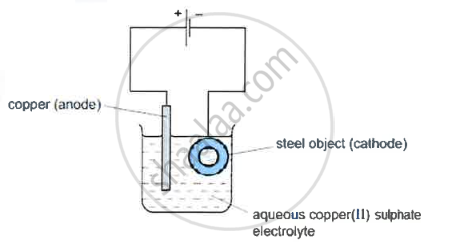Advertisements
Advertisements
Question
How would you change Cu2+ ion to Cu?
Solution
By supplying two electrons to Cu2+ or by loss of 2 electrons.
\[\ce{Cu^2+ + 2e- -> Cu}\]
APPEARS IN
RELATED QUESTIONS
Give reasons why In the electroplating of an article with silver, the electrolyte sodium argentocyanide solution is preferred over silver nitrate solution.
State one relevant observation for the following:
At the anode when aqueous copper sulphate solution is electrolysed using copper electrodes.
Choose the correct answer from the options given below:
The electrolyte used for electroplating an article with silver is
A. Silver nitrate solution
B. Silver cyanide solution
C. Sodium argentocyanide solution
D. Nickel sulfate solution
List out the main applications of electrolysis.
The following question relate to the electroplating of an article with silver.
What ions must be present in the electrolyte?
The following question relate to the electroplating of an article with silver.
What should be the nature of the anode?
Element X is a metal with valency 2. Element Y is a non-metal with valency 3.
(a) Write equations to show how X and Y form ions.
(b) If Y is diatomic gas, write the equation for the direct combination of X and Y to form a compound.
(c) Write two applications of electrolysis in which anode diminish in mass.
(d) If the compound formed between X and Y is melted and an electric current passed through the molten compound, the element X will be obtained at the _____ and the Y at the ________of the electrolytic cell. (Provide the missing words).
What ions must be present in a solution used for electroplating a particular metal?
Write two applications of electrolysis in which the anode diminishes in mass.
Electroplating steel objects with silver involves a three-step process.
Step 1: A coating of copper is applied to the object.
Step 2: A coating of nickel is applied to the object.
Step 3: The coating of silver is applied to the object.
-
- A diagram of the apparatus used for step 1 is shown

- The chemical process taking place on the surface of the object is \[\ce{Cu^2+(aq) + 2e- ->Cu(s)}\]
What is the observation seen on the surface of the object? - Explain why the concentration of copper ions in the electrolyte remains constant throughout step 1.
- The chemical process taking place on the surface of the object is \[\ce{Cu^2+(aq) + 2e- ->Cu(s)}\]
- A diagram of the apparatus used for step 1 is shown
- Give two changes which would be needed in order to coat nickel on to the object in step 2.
- Write down the reaction taking place at the positive electrode during step 3.
